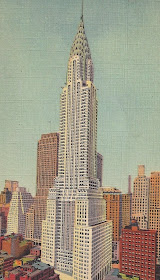 |
| The Leonard Jerome mansion. |
.jpg) |
| The New York Merchandise Mart, which replaced the Jerome mansion |
While it's not surprising that 71 Pearl was never part of a picture-postcard view (and, in fact, James was able to find only one photo of it, below), it was a little surprising that the Jerome mansion, which later housed the Union and Manhattan clubs, never warranted a postcard image.
 |
| The building in the center (slightly obscured by the El tracks) is 71 Pearl Street. Notice the arched windows on the second floor, the basis for its landmark designation. |
 |
| Courtesy of the exhibition "Flatiron High and Low." (https://vanalen.org/projects/flatiron-high-and-low/) |
Read James's entire story about these two demolished landmarks at http://curbed.com/archives/2015/04/29/how-some-of-nycs-first-landmarked-buildings-became-rubble.php.
* * * *
Explore more NYC history in
If you haven't had a chance to pick up a copy of Footprints yet,
you can order it from your favorite online retailers (Amazon, Barnes and Noble, etc.) or
from independent bookstores across the country.
you can order it from your favorite online retailers (Amazon, Barnes and Noble, etc.) or
from independent bookstores across the country.
And, of course, Inside the Apple is available at fine bookstores everywhere.











